2014 FORD MONDEO tow bar
[x] Cancel search: tow barPage 7 of 446

Downloaded from www.Manualslib.com manuals search engine Wheels and Tires
General Information...................................260
Temporary Mobility Kit..............................260
Tire Care..........................................................263
Using Winter Tires.......................................264
Using Snow Chains.....................................264
Tire Pressure Monitoring System..........264
Changing a Road Wheel...........................268
Tire Pressures................................................273
Lug Nuts..........................................................276
Capacities and Specific-ations
Vehicle Dimensions.....................................277
Towbar Dimensions....................................278
Vehicle Identification Plate.....................280
Vehicle Identification Number.................281
Capacities and Specifications - 1.0LEcoBoost™.................................................281
Capacities and Specifications - 1.5LEcoBoost™................................................283
Capacities and Specifications - 2.0LEcoBoost™...............................................284
Capacities and Specifications - 2.5L....285
Capacities and Specifications - 1.5LDuratorq-TDCi Diesel.............................287
Capacities and Specifications - 1.6LDiesel...........................................................288
Capacities and Specifications - 2.0LDiesel...........................................................289
Fuel Consumption Figures........................291
Audio System
General Information...................................292
Audio Unit.......................................................293
Audio Unit - Vehicles With: AM/FM/CD/SYNC............................................................296
Audio Unit - Vehicles With: Sony AM/FM/CD..................................................................297
Digital Radio...................................................301
Audio Input Jack..........................................303
USB Port.........................................................304
Media Hub......................................................304
SYNC™
General Information...................................305
Using Voice Recognition...........................306
Using SYNC™ With Your Phone...........309
SYNC™ Applications and Services......320
Using SYNC™ With Your MediaPlayer............................................................327
SYNC™ Troubleshooting..........................333
SYNC™ 2
General Information...................................343
Settings...........................................................352
Entertainment..............................................366
Phone...............................................................375
Information....................................................383
Climate............................................................388
Navigation......................................................390
SYNC™ Troubleshooting........................400
Appendices
Electromagnetic Compatibility.............408
End User License Agreement.................409
5Mondeo (CNG) Vehicles Built From: 08-09-2014 Vehicles Built Up To: 19-04-2015, CG3633en enGBR, Edition date: 10/2014, First PrintingTable of Contents
Page 130 of 446

Downloaded from www.Manualslib.com manuals search engine Tilting Head Restraints
The front head restraints tilt for extracomfort. To tilt the head restraint, do thefollowing:
1.Adjust the seatback to an uprightdriving or riding position.
2.Pivot the head restraint forward towardyour head to the desired position.
After the head restraint reaches theforward-most tilt position, pivoting itforward again will then release it to therearward, un-tilted position.
MANUAL SEATS
WARNINGS
Do not adjust the driver's seat or seatback when your vehicle is moving.
Rock the seat backward and forwardafter releasing the lever to make surethat it is fully engaged.
Reclining the seat back can cause anoccupant to slide under the seat'ssafety belt, resulting in severepersonal injuries in the event of a collision.
The manual front seats may consist of:
a bar to move the seat backwardand forwardA
a control to adjust the lumbar ofthe seat backB
a lever to adjust the height of theseatC
a lever to adjust the angle of theseat backD
POWER SEATS - VEHICLES
WITHOUT: MULTI-CONTOUR
SEATS
WARNINGS
Do not adjust the driver's seat orseatback when your vehicle ismoving.
Do not place cargo or any objectsbehind the seatback before returningit to the original position.
128Mondeo (CNG) Vehicles Built From: 08-09-2014 Vehicles Built Up To: 19-04-2015, CG3633en enGBR, Edition date: 10/2014, First PrintingSeats
Page 200 of 446

Downloaded from www.Manualslib.com manuals search engine The following are other situations that maylimit the Cross Traffic Alert system:
•Adjacently parked vehicles or objectsobstructing the sensors.
•Approaching vehicles passing atspeeds greater than 15 mph (24 km/h).
•Driving in reverse faster than 5 mph(8 km/h).
•Backing out of an angled parking spot.
False Alerts
Note:If your vehicle has a trailer towmodule approved by us, the system willdetect a connected trailer and turn off. Fornon-factory equipped tow bars, you maywant to turn the Blind Spot InformationSystem off manually.
There may be certain instances when thereis a false alert by either the Blind SpotInformation or the Cross Traffic Alertsystems that illuminates the alert indicatorwith no vehicle in the coverage zone. Someamount of false alerts are normal; they aretemporary and self-correct.
Detection Errors
If either system senses a problem with theleft or right sensor, the Blind SpotInformation System warning indicator willilluminate and a message will appear inthe information display.
All other system faults will display onlywith a message in the information display.See Information Messages (page 96).
Switching the Systems Off and On
You can temporarily switch off one or bothsystems in the information display. SeeInformation Messages (page 96). Whenyou switch off the Blind Spot InformationSystem, you will not receive alerts and theinformation display will display a systemoff message.
Note:The Cross Traffic Alert system alwaysswitches on whenever the ignition isswitched on. However, the Blind SpotInformation System will remember the lastselected on or off setting.
One or both systems cannot be switchedoff when MyKey is used. See Principle ofOperation (page 38).
You can also have one or both systemsswitched off permanently at an authorizeddealer. Once switched off, the system canonly be switched back on at an authorizeddealer.
TRAFFIC SIGN RECOGNITION
Principle of Operation
WARNINGS
The system does not relieve you ofyour responsibility to drive with duecare and attention.
At all times you are responsible forcontrolling your vehicle, supervisingthe system and intervening ifrequired.
If the sensor becomes blocked thesystem may not function.
Note:In cold and severe weather conditionsthe system may not function. Rain, snow,spray and large contrasts in lighting can allprevent the sensor from functioningcorrectly.
Note:Do not carry out windshield repairsin the immediate area surrounding thesensor.
Note:If your vehicle has a suspension kitnot approved by us, the system may notfunction correctly.
Note:Always fit Ford original parts whenreplacing headlamp bulbs. Other bulbs mayreduce system performance.
198Mondeo (CNG) Vehicles Built From: 08-09-2014 Vehicles Built Up To: 19-04-2015, CG3633en enGBR, Edition date: 10/2014, First PrintingDriving Aids
Page 210 of 446
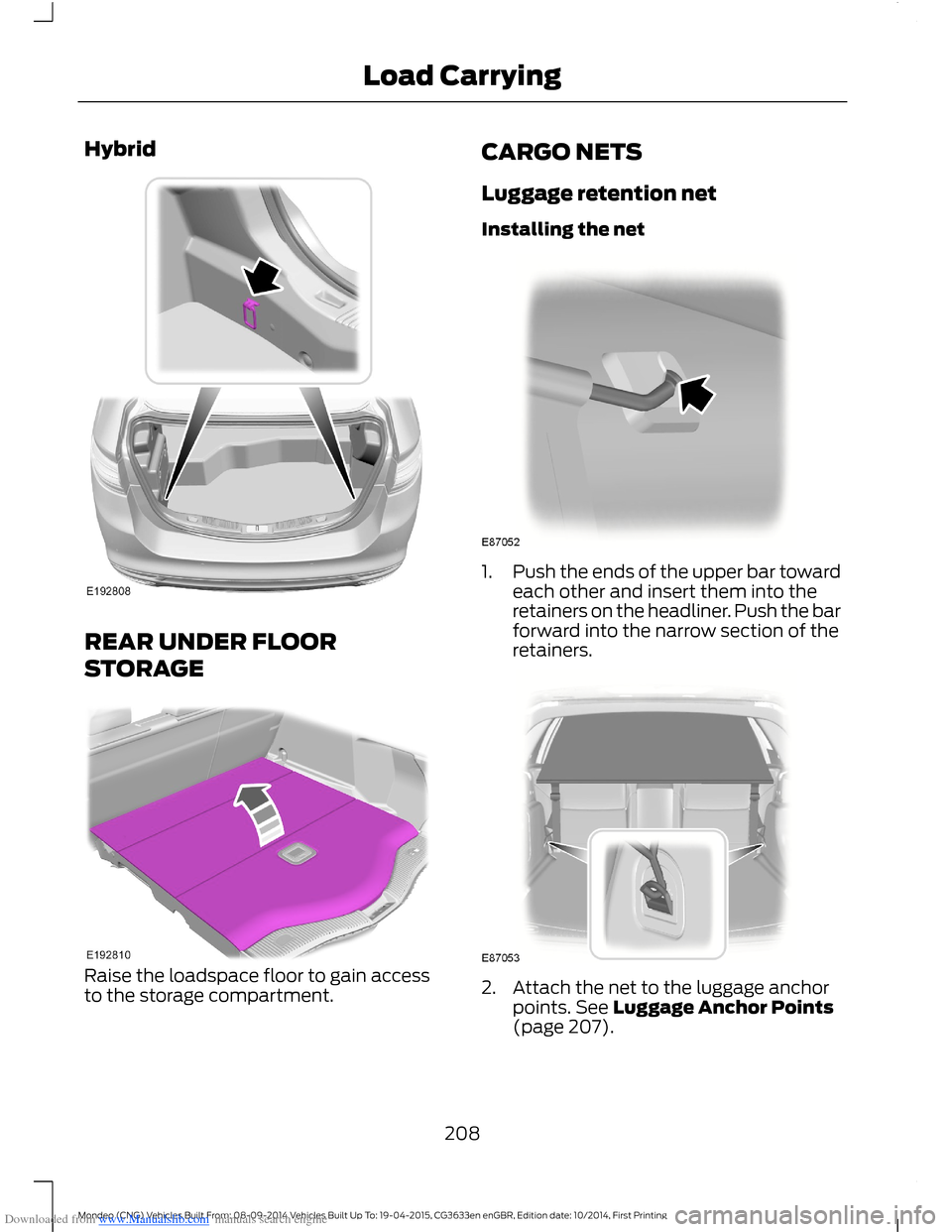
Downloaded from www.Manualslib.com manuals search engine Hybrid
REAR UNDER FLOOR
STORAGE
Raise the loadspace floor to gain accessto the storage compartment.
CARGO NETS
Luggage retention net
Installing the net
1.Push the ends of the upper bar towardeach other and insert them into theretainers on the headliner. Push the barforward into the narrow section of theretainers.
2.Attach the net to the luggage anchorpoints. See Luggage Anchor Points(page 207).
208Mondeo (CNG) Vehicles Built From: 08-09-2014 Vehicles Built Up To: 19-04-2015, CG3633en enGBR, Edition date: 10/2014, First PrintingLoad Carrying
Page 212 of 446
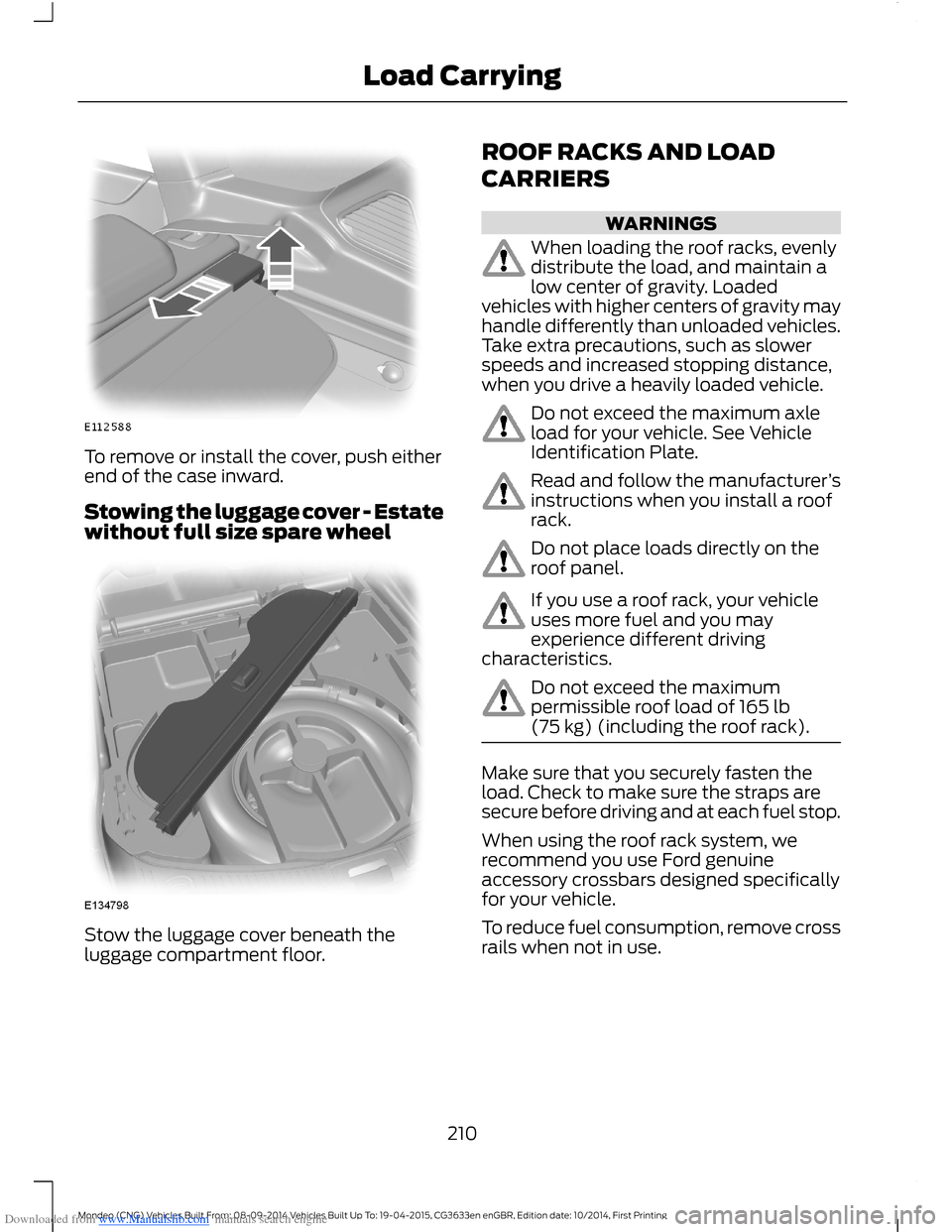
Downloaded from www.Manualslib.com manuals search engine To remove or install the cover, push eitherend of the case inward.
Stowing the luggage cover - Estatewithout full size spare wheel
Stow the luggage cover beneath theluggage compartment floor.
ROOF RACKS AND LOAD
CARRIERS
WARNINGS
When loading the roof racks, evenlydistribute the load, and maintain alow center of gravity. Loadedvehicles with higher centers of gravity mayhandle differently than unloaded vehicles.Take extra precautions, such as slowerspeeds and increased stopping distance,when you drive a heavily loaded vehicle.
Do not exceed the maximum axleload for your vehicle. See VehicleIdentification Plate.
Read and follow the manufacturer’sinstructions when you install a roofrack.
Do not place loads directly on theroof panel.
If you use a roof rack, your vehicleuses more fuel and you mayexperience different drivingcharacteristics.
Do not exceed the maximumpermissible roof load of 165 lb(75 kg) (including the roof rack).
Make sure that you securely fasten theload. Check to make sure the straps aresecure before driving and at each fuel stop.
When using the roof rack system, werecommend you use Ford genuineaccessory crossbars designed specificallyfor your vehicle.
To reduce fuel consumption, remove crossrails when not in use.
210Mondeo (CNG) Vehicles Built From: 08-09-2014 Vehicles Built Up To: 19-04-2015, CG3633en enGBR, Edition date: 10/2014, First PrintingLoad Carrying
Page 214 of 446
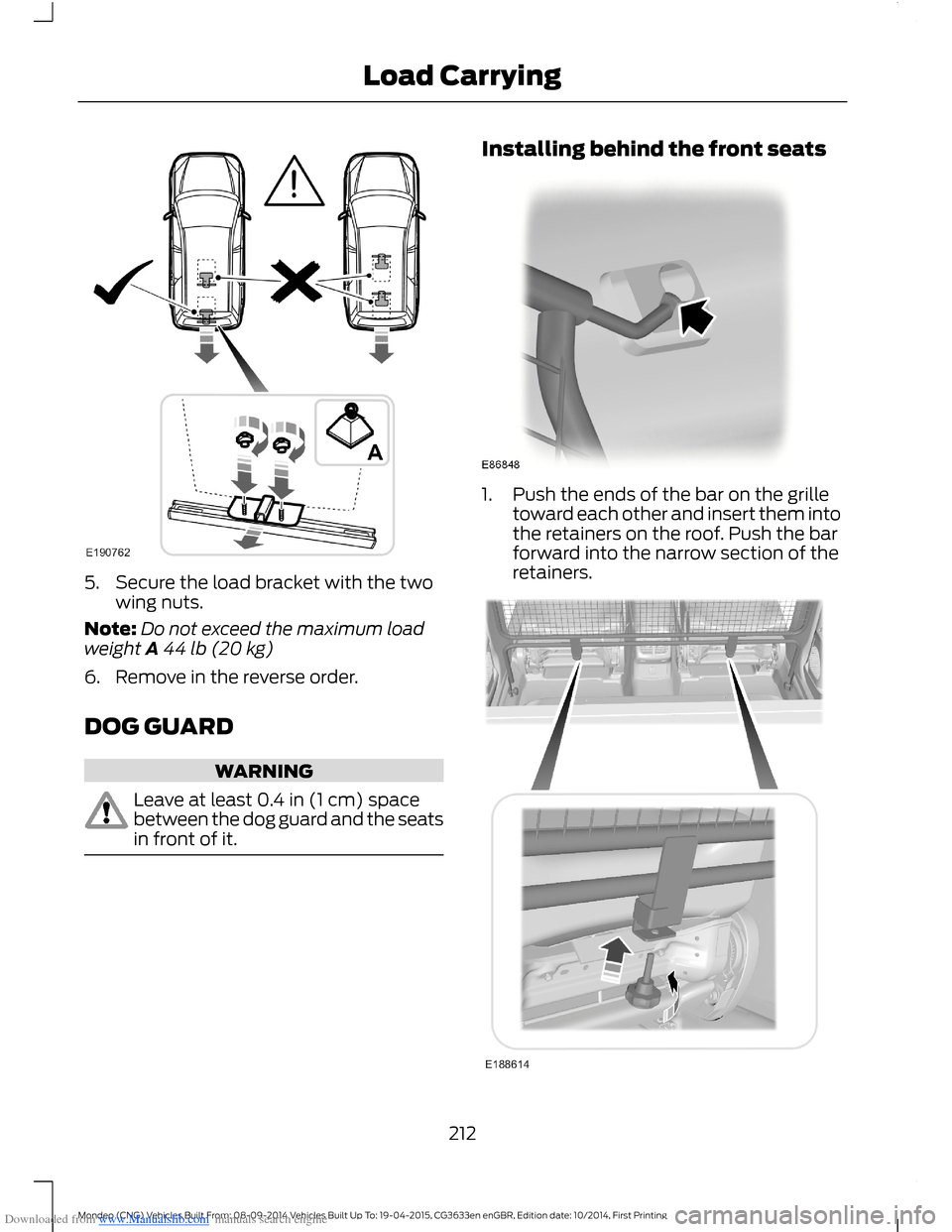
Downloaded from www.Manualslib.com manuals search engine 5.Secure the load bracket with the twowing nuts.
Note:Do not exceed the maximum loadweight A44 lb (20 kg)
6.Remove in the reverse order.
DOG GUARD
WARNING
Leave at least 0.4 in (1 cm) spacebetween the dog guard and the seatsin front of it.
Installing behind the front seats
1.Push the ends of the bar on the grilletoward each other and insert them intothe retainers on the roof. Push the barforward into the narrow section of theretainers.
212Mondeo (CNG) Vehicles Built From: 08-09-2014 Vehicles Built Up To: 19-04-2015, CG3633en enGBR, Edition date: 10/2014, First PrintingLoad Carrying
Page 215 of 446
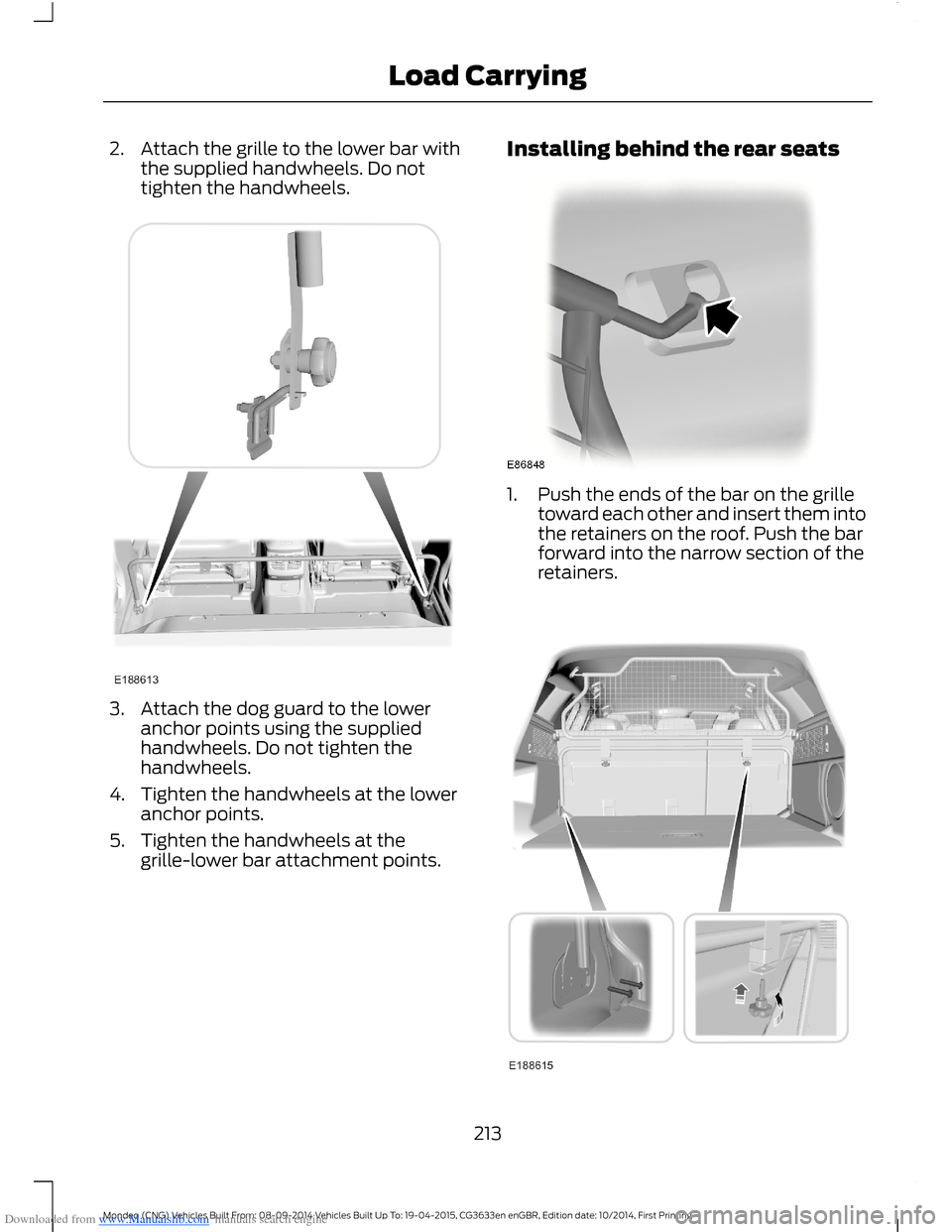
Downloaded from www.Manualslib.com manuals search engine 2.Attach the grille to the lower bar withthe supplied handwheels. Do nottighten the handwheels.
3.Attach the dog guard to the loweranchor points using the suppliedhandwheels. Do not tighten thehandwheels.
4.Tighten the handwheels at the loweranchor points.
5.Tighten the handwheels at thegrille-lower bar attachment points.
Installing behind the rear seats
1.Push the ends of the bar on the grilletoward each other and insert them intothe retainers on the roof. Push the barforward into the narrow section of theretainers.
213Mondeo (CNG) Vehicles Built From: 08-09-2014 Vehicles Built Up To: 19-04-2015, CG3633en enGBR, Edition date: 10/2014, First PrintingLoad Carrying
Page 217 of 446
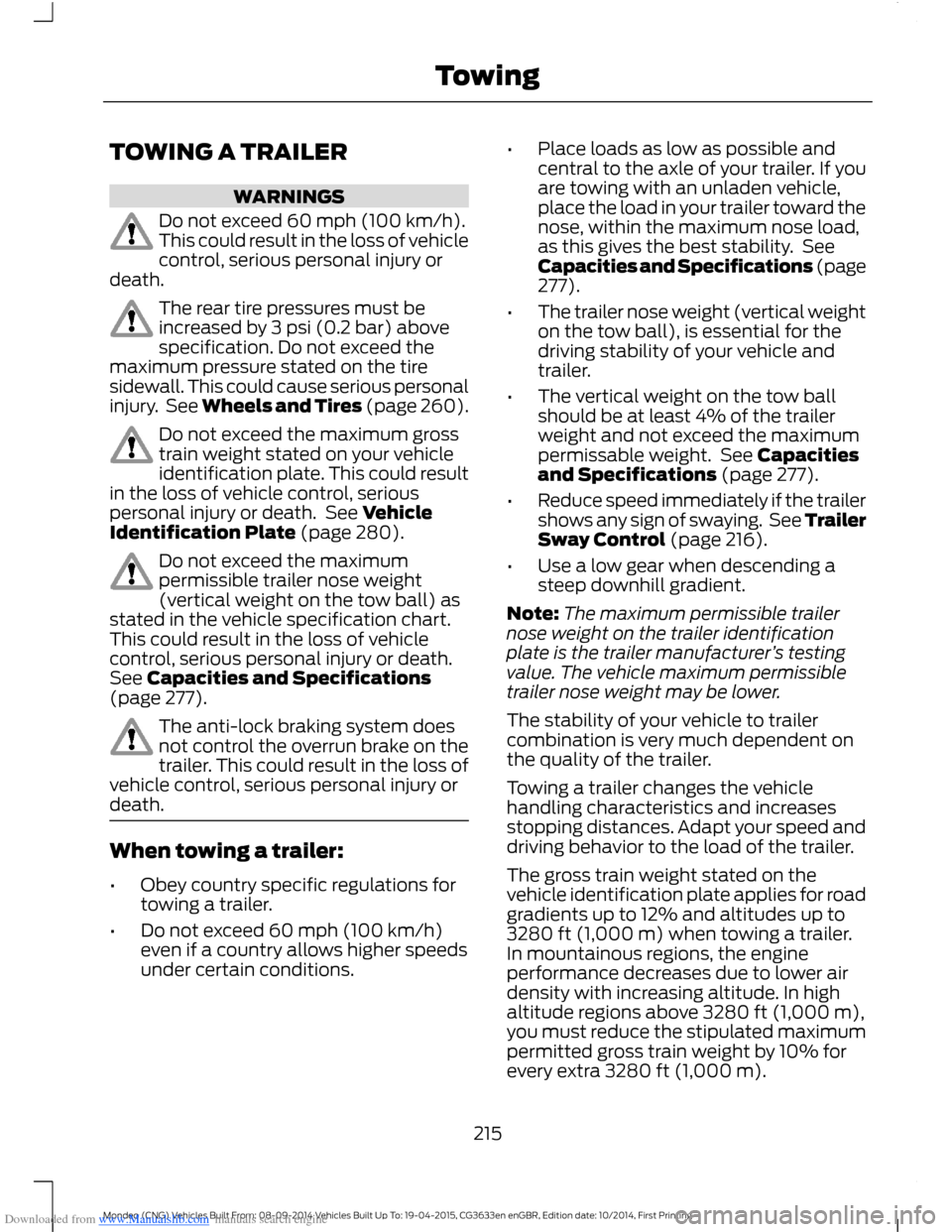
Downloaded from www.Manualslib.com manuals search engine TOWING A TRAILER
WARNINGS
Do not exceed 60 mph (100 km/h).This could result in the loss of vehiclecontrol, serious personal injury ordeath.
The rear tire pressures must beincreased by 3 psi (0.2 bar) abovespecification. Do not exceed themaximum pressure stated on the tiresidewall. This could cause serious personalinjury. See Wheels and Tires (page 260).
Do not exceed the maximum grosstrain weight stated on your vehicleidentification plate. This could resultin the loss of vehicle control, seriouspersonal injury or death. See VehicleIdentification Plate (page 280).
Do not exceed the maximumpermissible trailer nose weight(vertical weight on the tow ball) asstated in the vehicle specification chart.This could result in the loss of vehiclecontrol, serious personal injury or death.See Capacities and Specifications(page 277).
The anti-lock braking system doesnot control the overrun brake on thetrailer. This could result in the loss ofvehicle control, serious personal injury ordeath.
When towing a trailer:
•Obey country specific regulations fortowing a trailer.
•Do not exceed 60 mph (100 km/h)even if a country allows higher speedsunder certain conditions.
•Place loads as low as possible andcentral to the axle of your trailer. If youare towing with an unladen vehicle,place the load in your trailer toward thenose, within the maximum nose load,as this gives the best stability. SeeCapacities and Specifications (page277).
•The trailer nose weight (vertical weighton the tow ball), is essential for thedriving stability of your vehicle andtrailer.
•The vertical weight on the tow ballshould be at least 4% of the trailerweight and not exceed the maximumpermissable weight. See Capacitiesand Specifications (page 277).
•Reduce speed immediately if the trailershows any sign of swaying. See TrailerSway Control (page 216).
•Use a low gear when descending asteep downhill gradient.
Note:The maximum permissible trailernose weight on the trailer identificationplate is the trailer manufacturer’s testingvalue. The vehicle maximum permissibletrailer nose weight may be lower.
The stability of your vehicle to trailercombination is very much dependent onthe quality of the trailer.
Towing a trailer changes the vehiclehandling characteristics and increasesstopping distances. Adapt your speed anddriving behavior to the load of the trailer.
The gross train weight stated on thevehicle identification plate applies for roadgradients up to 12% and altitudes up to3280 ft (1,000 m) when towing a trailer.In mountainous regions, the engineperformance decreases due to lower airdensity with increasing altitude. In highaltitude regions above 3280 ft (1,000 m),you must reduce the stipulated maximumpermitted gross train weight by 10% forevery extra 3280 ft (1,000 m).
215Mondeo (CNG) Vehicles Built From: 08-09-2014 Vehicles Built Up To: 19-04-2015, CG3633en enGBR, Edition date: 10/2014, First PrintingTowing